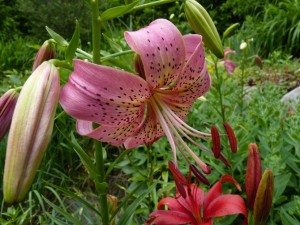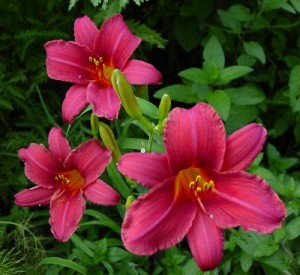Mid-Summer Waxing Honey Flow Moon
Mark and I transplanted hemerocallis (daylily) from the tiered gardens in the back to a front bed defined by a bur oak now in its 17th year and a Norway pine equally old. What we’re  doing is gradually filling in spots on our grounds that seem to always require weeding, maintenance with plants that are hardy, go it alone types. The hemerocallis, like the hosta, receive scorn from landscape designers and permaculture folks, but like all God’s creatures, they too have a place. And their place is to grow in those places you don’t want to have to worry or fuss about. As we get older, we plan to retire more and more beds to this kind of planting, reducing the ongoing work until we have only some vegetables in a raised bed or two and the orchard. The rest will be in asiatic lilies, hemerocallis, hosta, bugbane, grasses, ferns, bulbs like tulips and daffodils, monkshod and various shrubs.
doing is gradually filling in spots on our grounds that seem to always require weeding, maintenance with plants that are hardy, go it alone types. The hemerocallis, like the hosta, receive scorn from landscape designers and permaculture folks, but like all God’s creatures, they too have a place. And their place is to grow in those places you don’t want to have to worry or fuss about. As we get older, we plan to retire more and more beds to this kind of planting, reducing the ongoing work until we have only some vegetables in a raised bed or two and the orchard. The rest will be in asiatic lilies, hemerocallis, hosta, bugbane, grasses, ferns, bulbs like tulips and daffodils, monkshod and various shrubs.
We don’t want to nor do we need to get there all of a sudden. We still love the bees, the vegetable garden, the orchard and the perennials, but realistically there will come a time when weeding, planting and transplanting will no longer be fun, but will turn into chores. At that point we want to have grounds that correspond to our willingness and ability to care for them.
Kate’s retirement has brought up a lot of these questions. We love her retirement and the success she’s shown in recovering from her recent, second, hip replacement. That means a lot of things that were too painful in the past, like long car rides and train trips, may become more possible. So, we’re not shuttling back into the shell until the end, just trying to be realistic about life’s changes that are ahead and inevitable.

 bed. Hemerocallis (day lilies) are the blue collar workers of the perennial beds. They work hard, are hardy and bloom like crazy in August. They also have grow out, expanding their territories. And they never die. Hemerocallis are forever.
bed. Hemerocallis (day lilies) are the blue collar workers of the perennial beds. They work hard, are hardy and bloom like crazy in August. They also have grow out, expanding their territories. And they never die. Hemerocallis are forever.